Abstract
Urban furniture is a wide collection of objects of different sizes and geometries, performing different functions in the city. The paper describes the history and contemporary development trends of urban furniture. It analyses the construction materials most often used in their production, as well as functional and aesthetic solutions. A questionnaire survey, exploring the issue of urban furniture from the view point of the student population, was statistically analysed. It showed the preferences and expectations of current and future users of urban furniture, which can be helpful in achieving harmony between the creation of a positive image of the city and the comfort of public spaces for its residents. In the study of the preferences of urban furniture users, contingency tables were used for questions with a possible single answer. The results of questions with possible multiple answers were illustrated using Venn diagrams or equivalent UpSetR charts.
1. Introduction
Contemporary urban space is a carrier of identity and multiple meanings. On one hand, it is shaped by professionals, architects, and urban planners who want to fulfil themselves as creators as well as encourage the public to go out and use public spaces created for them. On the other hand, albeit not directly, it is shaped by the residents who use them. Urban furniture can facilitate that in various ways. It provides residents with safety of movement at night (lighting carriers), orientation in space (information carriers), quick access to information (announcement poles, infomercials, displays with maps of the city and the course of the communication line), improved public transport (parking meters, bicycle racks, bus shelters, restrictor posts), and opportunities for rest (benches, platforms).
Thanks to their originality, a lot of urban furniture pieces are artistic objects, acting as urban sculptures that can both harmonise with the space, as well as through expressiveness enter the foreground, drawing attention away from less attractive objects in the surroundings. However, following Carmona [1] “it is vitally important to design public spaces well, although experience suggests that often our ambition is not met by the reality”.
This paper presents the history and contemporary developmental trends of urban furniture including material, functional, and aesthetic solutions. The experimental part included a survey conducted among students of spatial management and architecture faculties at four universities in Poznań, Poland. The results were subjected to statistical analysis. Although they varied, they indicated that the appropriate arrangement of selected spaces provides an opportunity to improve their functionality, and thus the quality of life of residents, and increase the attractiveness of the street.
2. Literature Review
2.1. The Concept and Origins of Urban Furniture
The word “urban furniture” was developed in Europe in the 1960s. The term is defined differently, as private or public furnishings in public spaces that provide certain services and perform various public functions [2]. The Cambridge Dictionary defines urban furniture (street furniture) as objects and equipment installed for various purposes along streets and roads (dictionary.cambridge.org). Yang [2], recognising that the English term can be misleading and understood as fixtures present only on the street, developed a definition of street furniture according to the five elements analysed in Lynch’s [3] study. He included the following: (a) roads—lines along which we move, such as paths, streets, crosswalks, and railroads; (b) edges—lines that are barriers, linear elements such as rivers, railroad embankments, and walls; (c) areas—medium-to-large sections of the city, e.g.,: neighbourhoods and parks; (d) nodal points—intersections, places where spaces in the city intersect; and (e) landmarks, and he considered these to be urban furniture. Bao et al. [4] presented an alternative interpretation of the concept of urban furniture, combining the concept of indoor environment (interior design) and outdoor environment (urban landscaping). When people move from an indoor environment to an outdoor environment, their basic needs remain the same. Accordingly, furniture such as a sofa, telephone, or clock, for example, in urban public spaces becomes a bench, phone booth, and clock tower [5]. The aforementioned are just examples of different approaches to the classification of urban furniture.
The starting point for the history of public spaces and urban furniture was the period of the Industrial Revolution, considered the beginning of modern urban planning. So, following Benevolo [6], it was “the relationship between town planning and politics”. The advent of motor vehicles at the end of the 19th century led to a change in the organisation of traffic in cities; gas lamps, used as street lighting, were supplanted by street lamps, the light railroad forced the construction of bridges and stations, and the advent of newspapers and posters imposed the need for the construction of advertising poles. An expression of the evolution in the way we think about urban space is London’s Regent Street, built in 1811. It is an excellent example of a functional and representative street, thought out from the beginning as the city’s main street—expanding into a square from time to time, equipped with lampposts, benches, monuments, and all the street furniture a big-city street needs [6].
The 20th century was a time of further development, which, with its permissive and avant-garde approach, brought new solutions and thinking about space. Many unusual projects were created, which still today captivate with their excellence. Examples include the Piazza d’Italia square in New Orleans invented in 1978 by Charles Willard Moore—a furnished space for tranquility and relaxation between tall office buildings, and the Parc de la Vilette in Paris, where Swiss architect Bernard Tschumie designed furniture with unique forms, creating a space that is both welcoming and artistic [6].
Urban furniture has evolved and continues to evolve along with urban planning, but it was the 20th century that made it clear that urban furniture objects could not only be useful, but could also be works of art and symbols of the city.
2.2. The Role of Urban Furniture in Public Spaces
Urban furniture is a multifaceted object influenced by factors such as user needs, social structure, urban layout, geographical characteristics, technology, material, and cost [7].
Urban furniture is important in integrating residents. It provides a place to socialise thus attracting new users, enables the city to unite as a community, and creates a space where people can gather, share, and experience life together, but also experience solitude. A study by American urban planner Whyte [8] on the use of public spaces confirmed that places with more urban furniture, especially seating, appropriately located, are more likely to be visited. Research on the role of furniture in public spaces, which confirms and extends Whyte’s contribution, was also conducted by Gehl [9], a professor of urban planning at the School of Architecture in Copenhagen, and also a director of the Center for the Study of Public Spaces, in his groundbreaking book Life Between Buildings. He was observing and analysing how people were behaving in public spaces. With this, he determined how they should be arranged to promote social use. He stressed the importance of a good place arrangement, maintaining that only when there are opportunities for seating people can stop. When there are none—they move on.
Public spaces are not only places for recreation, but also an “extension” of the workplace. Modern technology, offering a variety of devices (laptops, cell phones), makes it possible to work outdoors, thus increasing the demand for amenities that provide work comfort, including urban furniture [10]. In addition, urban furniture can provide shelter from rain, snow, wind, or sun. It can bring new life to rail, bus, and road networks and make them safer. Increased awareness of the need to protect the environment increases the number of people using bicycles and thus looking for a place to park them in public spaces. Safety can also be enhanced by urban furniture in the form of street lighting [6].
Urban furniture pieces can become internationally recognised icons of cities [11]. Examples include the turn-of-the-century London telephone booth (Figure 1), which has become common to the whole United Kingdom with the exception of the cream-coloured telephone kiosks characteristic for the city of Hull or a collection of Parisian subway entrances. They served a dual purpose—both functionally and decoratively—as a recognisable element of the city. Urban furniture is effectively used to create visual order, including designating functional areas [10]. Research shows that people are more likely to navigate using visual cues and lines rather than written information. Urban furniture is also used for this purpose, creating landmarks that connect spaces and routes [12]. In addition to their basic functions, pieces of urban furniture sometimes constitute a kind of public art. They are mainly sculptures placed in urban spaces. They can be intended solely for decoration, but also for combining the functions of other urban furniture, including seating, lighting, signage, fountains, etc., and thus the aforementioned multi-tasking [5].
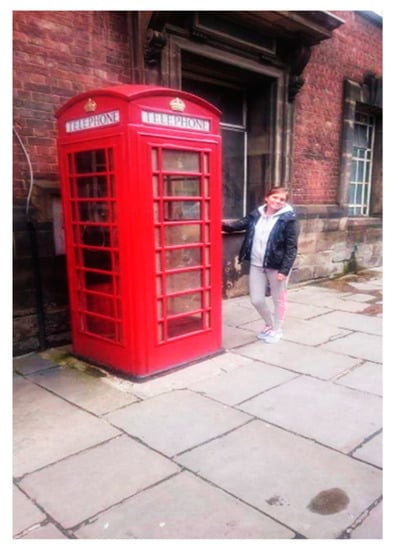
Figure 1.
London telephone booth (photo: W. Wiza).
2.3. Urban Furniture Planning Process in Public Spaces
Furniture planning begins with defining the type of space under consideration (park, street, recreational area, etc.). Undoubtedly, spaces whose furnishings are coordinated as part of a broader design concept (taking into account user needs, architectural character, or weather conditions) are more successful [10].
The location of furniture should be based on its functions and be consistent with its surroundings. According to German psychologist Arnheim: “To see an object in space means to see it in context” [13]. Furniture should not pose a threat or discomfort to pedestrians. It should also be designed with the elderly and disabled as users in mind [14]. In addition, urban furniture should be positioned in a way that stimulates socialising and integration with strangers. In his book The Hidden Dimension, anthropologist Edward T. Hall, following the principles of proxemics, described different types of spaces and pointed out measurable distances between people interacting. He defined comfort zones in the external sphere. He delineated four measures of distance: intimate (for touching or whispering), personal (for interaction between good friends), social (for integration with acquaintances), and public (for observation) [10]. Indeed, the sense of comfortable distance depends on the situation, population, gender, and individual preferences, which is especially important in densely populated areas with a large cross-section of cultures and customs.
Humphrey Osmond, an English psychiatrist, interested in the impact of the external environment on patients’ interactions, identified two main ways in which spaces are modelled: one—ring-like, tending to bring people together and encourage cognition and communication; the other—comparable to a square, with a tendency to separate people and suppress communication. With space arrangement and furniture placement, designers can influence users to become more or less integrated, for example, by directing people toward each other and encouraging face-to-face contact, or the opposite [10].
The location of urban furniture in a public space depends on how it is used (recreation: dynamic or static, street as a way to a destination). While users stay in larger groups, they prefer an arrangement of static places (resting, eating, chatting) similar to the style of a circle, which indicates the need for integration [15,16].
This confirms the importance of space design to facilitate contact and interaction between people and the preferences of future users of the space. Thus, users are, in a way, co-designers of furniture. The process of “co-design” ensures that the final product meets the needs of society, and further enriches the life of the community by promoting interaction between its members [17].
Undoubtedly, worth discussing is a new strategy design of street furniture that tends to choose flexible furniture because of limited space in urban areas. It can reduce material resources, energy, and space [18].
A consistent and useful source of knowledge and requirements for architects and urban planners placing furniture in urban spaces is a manual for designers written by Bentley et al. [19].
Although much is evolving in urban planning trends, with the inclusion of urban furniture, one of the crucial sources of knowledge for city planners and urban designers is still the book written by Lynch [3] with its first edition of 1960.
2.4. Urban Furniture Material Solutions
In the selection of material solutions for urban furniture, attention is paid to various aspects, including the following: technical and technological (strength and durability, safety of use, life cycle impact, reusability), spatial, economic (including wear and tear), sensory (user comfort, acoustics, lighting, appearance), or psychological (including well-being). Of tangible importance, constituting the quality of furniture, are strength and durability (due to their external location), along with “aesthetic” durability, because urban furniture is expected to be aesthetically pleasing throughout its use.
Today, the most popular materials used for urban furniture are still traditional materials: metals and their alloys, wood, natural stone, concrete, and plastics.
2.4.1. Metals and Alloys
Soffritti et al. [20] considered the history of cast iron (CI) street furniture, which started during the First Industrial Revolution, and it could be treated as relevant culture heritage. The authors mentioned the regrettable loss of most CI street furniture from World War II and the lack of sufficient preservation up to this date. However, cast iron is nowadays also popular in the production of urban furniture. The furniture is based on solid and stable castings, and is usually finished with wooden planks, which give it a warm and friendly character.
Currently, among the metals and their alloys used in the manufacture of furniture, steel predominates (with exclusion from open, sunny areas because of its heatability), due to its high strength and recyclability, in order to improve durability parameters—with chromium, manganese, or molybdenum content, or electroplated. Corten steel, self-healing with improved corrosion resistance, is becoming commonly used. Due to its rusty color, it is increasingly used in the design of post-industrial and modern spaces, optimal for use both in art installations and as reinforcement and decoration for fences, pots, and walls in combination with glass and concrete [21].
Inflatable steel is extremely interesting and one of the most recognisable Polish products in the world, usually in the form of steel sheets welded along the outline, which become three-dimensional elements when inflated under high pressure. This revolutionary FiDU (German: Freie Innendruck Umformung) technology—free internal pressure moulding developed by Polish designer Oskar Zięta—is used to produce, among other things, urban furniture.
Aluminum is also an excellent material choice for outdoor furniture. It is strong, highly weather-resistant, to be moulded into variety of shapes, and its powder coating provides many colour options and increased protection from scratches. Aluminum furniture is very lightweight, making it suitable as mobile furniture [22].
2.4.2. Wood
Wood is often used in the production of urban furniture. It is a natural, environmentally friendly material, and, when properly impregnated, can form the cladding of platforms and seats, making them safer to elderly people and people with limited mobility, and friendly for adults with small children as well. [23]. Unlike metals and their alloys, it does not heat up as easily. Its disadvantages are the need for maintenance and greater susceptibility to vandalism. The choice of wood type should depend on the location and frequency of use of the furniture. For example, pine is a relatively inexpensive material. Pine wood is resilient, durable, and easy to work with, but it changes colour quickly when exposed to ultraviolet (UV) radiation and, if not maintained, maintenance or replacement costs can exceed the initial purchase cost. For making urban furniture, teak wood is ideal, practically not swelling, not shrinking, not soaking up water, and is also resistant to biological, chemical, and atmospheric agents. Its disadvantage is its high price. Eucalyptus wood is also a very suitable material, with high resistance to moisture and mechanical damage, and high hardness. It is cheaper than teak, but requires the use of a sealing agent to improve its resistance to biological agents and minimise the negative impact of uneven moisture retention. Some proposals of implementation of high-density cork for the seats and backs of urban furniture have been appeared in the literature. The material is resistant to wear ageing, solar exposure, and weather conditions [24].
2.4.3. Concrete
Another material often used in the design and manufacture of urban furniture is concrete. Its advantages include durability, provided that it is properly designed and carefully manufactured. Concrete furniture is most often made of architectural concrete, which, unlike traditional concrete, can be ground, polished, textured, and/or coloured. Thanks to its heavy weight, it does not need to be mounted and fixed to the ground, which is, however, a disadvantage in the case of mobile furniture. As an environmentally respectful attitude, some urban furniture, e.g., benches, can be made of concrete containing recycled aggregate [25]. Bedoya et al. [26] proposed using the addition of coal ash for concrete to produce some urban furniture. Recently, cellular light-weight concrete has been developed as a material for a modular design of multifunctional and adaptable park furniture, as it is durable and has good resistance to extreme weather [27]. Concrete is a material that offers possibilities for creating a variety of shapes. However, its aesthetics are sometimes controversial—some of its opponents see concrete furniture as too heavy, and also point to the long process of drying out after rain. Nowadays, polymer concrete, a variety of concrete in which cement is replaced by a synthetic resin with a hardener and a filler in the form of quartz powder, is also increasingly used for the production of urban furniture, so that “synthetic” concrete is poreless, shows greater strength, and is more resistant to external conditions.
2.4.4. Natural Stone
Natural stone shows similar properties to concrete. Furniture made of it is successfully used for public spaces. Architecture based on this material fits well into urban space and the rural landscape. The high resistance of some stones to changing climatic conditions allows it to serve users of urban furniture for many years. The combination of stone and steel in the form of gabions (Figure 2) is being used more and more boldly, as elements of fences, retaining walls, or modern seats and pots [21].
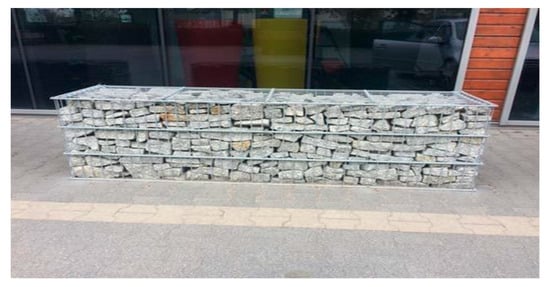
Figure 2.
Combination of stainless steel with natural stone in the example of a gabion bench (photo: W. Wiza).
2.4.5. Plastics
Plastics, mainly PVC (Polyvinyl Chloride), are also frequently used materials for urban furniture. They are recyclable, durable, and easy to maintain, making them cost-effective for long-term use [22]. A major advantage is the wide colour options and lightness, which make plastics very suitable as a material for mobile furniture. The disadvantage is often low UV resistance, so that, when exposed to prolonged sunlight, they fade. In addition to PVC, plastics useful for making urban furniture include polypropylene (resistant to chemical degradation and higher temperatures), polycarbonate (durable, impact resistant, but prone to scratching, used when transparency is desired), or a similar but cheaper and less crack-resistant acrylic or polymethylmethacrylate (astromal.pl).
2.4.6. Sustainable Materials
In light of the emphasis on sustainability, the use of environmentally friendly materials is advocated. Thanks to modern developments in technology, it is possible to use recycled materials, which accounts for the reduction in natural resource consumption and carbon footprint [22]. Sustainable materials are those that are smart, tailored to the needs and location, durable, reduce energy demand, and come from a proven, reliable source. Local governments are increasingly taking initiatives to use such materials. An example of efforts is the replacement of incandescent light bulbs with new LED bulbs, reducing the energy consumption of street lighting by 40–70%. Renewable energy sources are also providing new opportunities, which can be used to replace street lamps with photovoltaic energy sources that generate energy, providing light and at the same time accumulating energy for the municipal power grid. Yücel [22] gives an example of using geothermal energy in a bench project. Through holes in the ground connected to the geothermal system, the temperature of the seat changes, providing comfort. Avila et al. [28] and Premier et al. [29] put stress on forward-looking solar furniture with light and heat sensors, lighting, which, thanks to its solar cells, is able to generate clean and sustainable energy. In recent years, furniture made from biological raw materials derived from various agricultural products and generated waste has also appeared on the market [30,31,32,33,34].
Examples of bio-based furniture include benches made from bioplastics based on grass and wood waste, as well as road signs made from bio-resins and wood fibres. The use of such materials can boost the market or recycled materials and a closed-loop economy, as well as reduce greenhouse gas emissions. Studies show that the trend of making bio-based polyvinyl chloride from ethylene can reduce greenhouse gas emissions by 40% compared to petrochemical alternatives. However, the above-described solutions are not yet widely used for urban furniture production due to innovation.
2.5. Aesthetic and Functional Solutions for Urban Furniture
Related to the aesthetics of urban furniture is its colour scheme. Colour is one of the basic tools of the architect and urban planner, sometimes also a business card and symbol of the city. The aforementioned telephone booths would not be London if it were not for the red colour. The colour yellow, however, brings to mind New York cabs. Cities try to define their identity through a colour, and history and heraldry often become helpful in determining the colour scheme. A colour in urban space informs, organises, and warns. It evokes emotions, can change the context of a place, and emphasises its uniqueness. [35,36].
The colour properties also have an impact on the human psyche. The space consciously uses accepted symbolic colour codes, in which white is associated with purity, yellow with joy, and green with relaxation. Colours also affect a person’s mood and the physiological state of his body: sharp deep red has an exciting effect, while cool green and light blue have a calming effect [35,36].
It is the latter two colours, thanks to their properties, which are often used in the design of relaxation zones and oases of tranquility, while sports zones, entertainment areas, and other areas, by design dynamic places, maintain a stimulating, vibrant colour scheme. By using a contrasting colour, it is possible to attract the viewer’s eye or, conversely, with a neutral colour, to discreetly hide and reduce the importance of some elements in order to emphasise and increase the prominence of others [21].
A colour can also affect the evaluation of objects—their size, weight, or distance. Perception of a colour is related to light and weather conditions. Colours are perceived differently in well-lit areas or on a bright sunny day, and differently on a foggy and rainy day. For this reason, a popular colour is red, which is easily visible in almost any conditions. The role of colour is increasingly appreciated by the authorities and the relevant departments of offices responsible for the aesthetics of the city, thanks to which projects are created that take into account a consistent colour scheme, which also applies to city furniture. One of the interesting and successful implementations involving just colour is the project “Bristol Legible City”, thanks to which a coherent system of urban identification was created: traffic lights, signs, information points about the city, tourist attractions, and touch panels and plaques commemorating fallen soldiers and prominent representatives of Bristol (Figure 3).
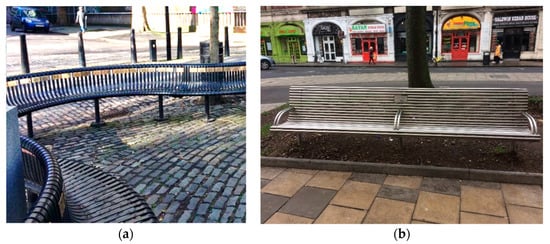
Figure 3.
Benches with plaques commemorating fallen soldiers, a characteristic element for English cities (a,b) (photo: W. Wiza).
Thanks to the installed information and signage system, the city of Bristol “spoke” to users in a visual language that was simple and easy to understand. A safe, convenient, easily accessible and colour-consistent centre was created.
The functionality of furniture is primarily linked to its ergonomics, and ergonomic design to industrial production. With the development of urban furniture, manufactured objects began to address all city residents and the problem of the “anonymous user” emerged. Hence, designers began to look for parameters that would be optimal for all users.
Although there are no clear-cut rules for urban furniture design regarding its parameters, several guidelines have been developed, the application of which can improve the comfort and safety of urban space participants. Each form of urban furniture has separate guidelines tailored to its function and location.
In the case of seating (e.g., benches), important factors include the following: height from ground level, height of the backrest, width, length, shape of seats, backrests and armrests, distance from the traffic corridor [37], and proximity to other elements of the space [22].
Waste containers should be located in areas of most likely use, with good visibility and accessibility to minimise littering, but also far enough away (if open or semi-open) from seating areas to minimise odour. It is not uncommon, unfortunately, for waste containers to be built into seats (Figure 4).
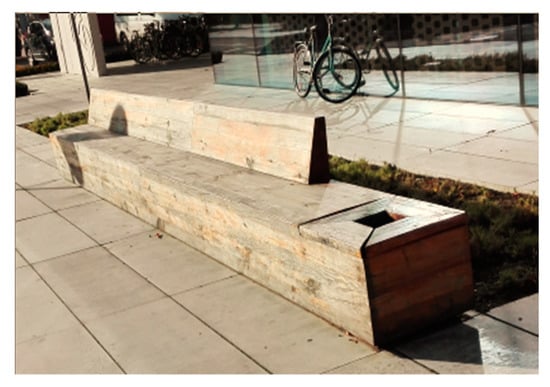
Figure 4.
Waste container built into a seat at a bus station in Wągrowiec, Poland (photo: W. Wiza).
Well-organised public spaces have several smaller, more frequently emptied bins, instead of one large one, matching the other elements of the space [21].
An important element of any public space is lighting with justifiable locations of its elements mainly along traffic routes and in areas of highest activity to increase the sense of security after dark [21]. An ergonomic, ecological, and practical solution, provided that it is properly placed in the space, is solar lanterns.
The functionality of urban furniture is also manifested in the innovation of solutions applied at the level of non-verbal communication (smart city). Modern technologies are increasingly being used in the design of contemporary urban furniture. Examples include advertising media, USB ports, and speakers built into elements of small architecture, as well as touch panels installed at bus stops having access to interactive timetables and thus allowing users to plan the route of a ride in a few seconds. The interactivity of urban fixtures provides faster access to information and enhances the education of public spaces. The multifunctionality of urban furniture, resulting from the innovation of solutions, is ideal for small spaces where one cannot afford to clutter the pedestrian space with too much equipment. Multifunctionality is also supported by mobility, which allows a given object to be quickly “transformed” into another (for example, benches that fold out into platforms for lying down) [21].
2.6. Parklets
Cities characterised by dense development often face traffic problems. This is combined with a reduction in sidewalk space and a paucity of green space in favour of parking spaces. Parklets may be the answer to the growing demand for public spaces. The concept, created by Americans in 2010, carves out new places in the space, which are usually an extension of the sidewalk and occupy an area of 2–3 parking spaces. The idea originated in San Francisco. A group of artists wanting to draw attention to the need to create new spaces for residents’ paid-for parking places, but instead of putting a car on it created temporary miniature public spaces with urban furniture and greenery. The space, which on a daily basis would only fit one car, used in an unconventional way, provides a place to meet and relax. Parklets consist of a platform, an enclosure that protects users from vehicles, and urban furniture that develops the designed area [38]. Parklets can be developed differently. Some provide a place to rest, others a place to work, some stimulate communal spending through installed games, and in others one can indulge in the passion of gardening.
A number of design guides have been produced on parklet forms, materials, and locations. Among the best known is The San Francisco Parklet Manual. The idea of parklets, initially thriving in the United States, is also entering Europe. It is very popular in Vienna, where 30 such zones were established in 2017 alone. In Poland, the first parklet was created in 2015 in Łódź as a pioneering and experimental solution, the second—in Rybnik, and the next are planned to be realised in Warsaw, Gdynia, Tarnów, and Włocławek. Thanks to the mobile form of developed space, it is possible to move the platform to different public spaces of the city and look for a place where it will enjoy the greatest interest, as well as to convince a larger group of residents to the idea.
2.7. Urban Furniture and the COVID-19 Pandemic
Urban furniture in some cases (e.g., benches, parklets) promotes increased contact between users. Due to it, urban furniture emphasises the rules of living together in order to sustain collective life, which is positive. However, the COVID-19 pandemic has enforced the greater awareness of users, especially in sunny days, because, according to Ardura et al. [39], contrary to expectations of higher virus survival in cold and humid days, the positive rate was significantly higher in sunny sampling days, reflecting a higher frequentation of public outdoors spaces.
In this context, the opinion of Askarizad and Jinhao He [40] of paying attention to the role of equilibrium between social interactions and the built environment in post-pandemic urban design seems to be particularly important. Into this narrative fit Mansuroglu et al. [41], stating that ‘’landscape architects need to gain experience in nature, natural factors and health relations in order to be able to design urban green spaces in harmony with nature and with consideration to public health”. The statement of the author stays in line with sustainable development.
3. Materials and Methods
3.1. Purpose and Scope of the Research
In Poland, urban furniture usually takes the form of point-like elements scattered in space. Among them, parklets are relatively new form. It inspired the authors of the paper to recognise the knowledge and opinions about urban furniture among potential users.
As part of the experimental and analytical research, a survey was conducted among students of spatial management and architecture faculties at four universities in Poznań, Poland, on existing furniture (opinions) and planned furniture (expectations). This group, although not a homogenous representation of the end users, was chosen because of its education, professionally related to the subject of urban furniture. The survey was aimed at the young, but surely urban furniture is a benefit for the elderly—a concern for the older generations, to whom much is owed and therefore it can be seen as a sign of respect towards them. Undoubtedly, it can be a benefit for other groups, such as, for example, children and people with disabilities.
3.2. Research Tools Used
The survey consisted of 19 questions, 13 of which related to urban furniture and 4 to parklets. It included questions on opinions about existing urban furniture (accessibility, aesthetics, frequency of use) and expectations and perceptions about planned furniture and parklets (characteristics of good urban furniture and good space). The survey questions are summarised in Appendix A.
The survey was conducted in spring 2019, electronically and on paper. Electronic surveying was possible using a Google form. The results obtained were transferred to graphs, which were made using an Excel spreadsheet.
Survey questions included groups of questions with a possible single answer or multiple answers. For the single-choice questions, Pearson’s chi-square test for contingency tables was used to test the homogeneity of the distribution of answers given in relation to the gender of the respondents, and the corresponding p-value was determined by simulation using the Monte Carlo method on the basis of 10,000 replications [42]. The results of the tests are shown in Table 1, and the percentage of responses given in relation to the categories considered (gender–question or question–question) is presented using spineplot charts, in which the widths of the bars reflect the proportion of the size of the groups surveyed, e.g., women and men.

Table 1.
Pearson’s chi-squared test with simulated p-value (based on 10,000 replicates) for survey questions relative to gender.
For questions for which the respondent had the option of selecting more than one (selecting up to three) answer, Venn diagrams were made to illustrate their distribution, or equivalent UpSetR-type charts. UpSetR visualises the “intersections” of sets as a matrix (part of the diagram with dots). The rows represent the sets under analysis, and the columns represent their intersections—the common parts (they correspond to the equivalent elements of Venn diagrams). Connected by a vertical dash, circles in the same column indicate for which categories (rows) the abundance of the common (intersection) part is given above the bar of that column.
For the sake of the clarity of the results, in some questions, similar answers (e.g., “yes” and “definitely yes”) were treated together. Statistical analysis and spineplot, UpSetR, and Venn diagrams were performed using R version 4.0.4 (R Core Team, Vienna, Austria).
4. Results and Discussion
A total of 203 students from four universities participated in the survey (including 53 from architecture, 42 from spatial management, and the rest from art studies), of which more than 67% were women. The results of the survey confirm the great importance of urban furniture in public spaces. The first question referred to the number of public spaces in the city of Poznań, which more than half of the respondents believe is insufficient. The next 12 questions dealt with opinions on existing urban furniture and expectations for designed furniture. More than 55% of the students admit that they use urban furniture daily, and 35.5% say they use it once a week (Figure 5a), with as many as 64% of the male percentage saying they use local furniture daily, and 29% using it once a week. Slightly different proportions were found among women: 51% and 39%, respectively. Although statistical analysis showed no significant differences between respondents’ preferences (Table 1), it is worth noting that the percentage of male respondents actively using urban spaces is higher than that of women (Figure 5b). This could be attributed to the greater variety of places visited by female students, in addition to open space, or the fulfilment by a larger proportion of male students of their expectations of places based on the structure of the city of Poznań.
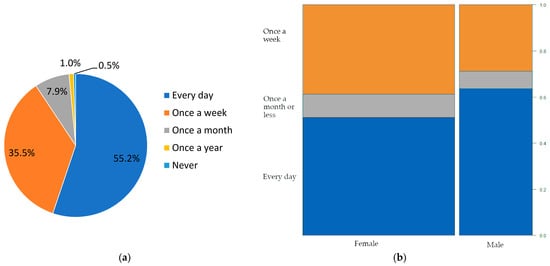
Figure 5.
(a) Results of answers to the question: “How often do you use city furniture?” (Own source). (b) The spineplot shows the percentage of the answers given in relation to the category (gender); the widths of the bars reflect the proportion of the size of the groups.
In addition, more than 66% of respondents believe that the amount of urban furniture in Poznań is not sufficient (Figure 6c). Nearly 42% of respondents felt that there is a lack of dedicated public spaces in the urban space and that the amount of furniture in them should be increased, while 20% of respondents are of the opinion that the number of dedicated spaces is sufficient and what is lacking is the amount of urban furniture. Only 9% of respondents see no need for changes in this regard (Figure 6a). Deficiencies in the amount of urban furniture are noted by almost 46% of those who use it daily and 18% of those who use it once a week. In the former group, only 1.5% of respondents found the current amount of urban furniture sufficient (Figure 6b). The frequency of use and the need for an increase in urban elements is undoubtedly a signal to city authorities and designers, all the stronger because it is the opinion of a part of the younger generation, in whom, due to the orientation of education, in addition to awareness of use, the aesthetic sense is an additional value.
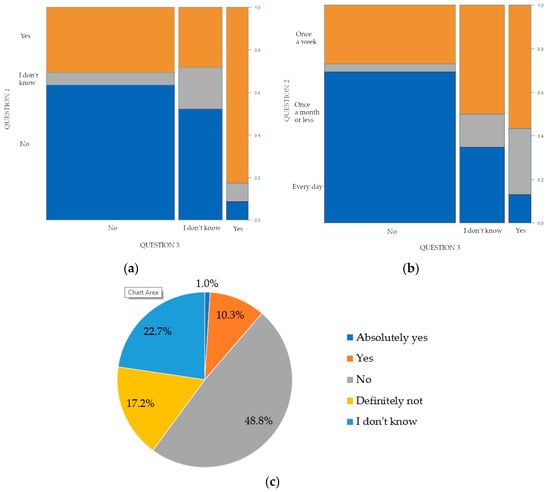
Figure 6.
(a) The spineplot shows results of answers to question 3 in relation to the answers to question 1; (b) The spineplot shows results of answers to question 3 in relation to the answers to question 2; (c) The results of responses to question 3 “Do you think the number of urban furniture in the city of Poznań is sufficient?” (Own source).
According to respondents, the city of Poznań lacks waste bins and benches the most. This was the answer marked by 149 and 108 students, respectively. Bicycle racks, public toilets, and greenery containers were also considered missing furniture. There were the fewest responses indicating an insufficient number of dog excrement containers and streetlights—29 and 19 responses, respectively (Figure 7a). Regardless of the perception of the number of separated public spaces as sufficient or not, the structure of students’ responses regarding missing urban furniture in public spaces was similar: in all groups, the most people indicated the lack of urban furniture from the “hygiene” group (Figure 7b); the distribution of answers was not influenced by the frequency of using street furniture either (Figure 7c).

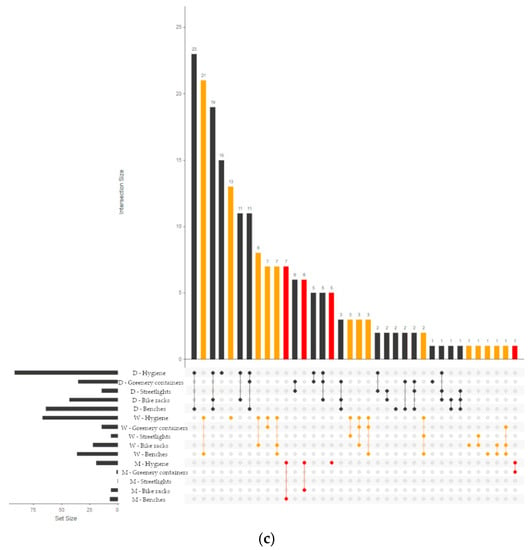
Figure 7.
(a) Venn diagram of distribution of the answer to the question: “What urban furniture do you think is missing in the public space of the city of Poznań?” (Own source). “Hygiene” includes responses regarding: “public toilets”, “dog excrement containers”, and “waste bins”; (b) UpSetR graph shows the structure of respondents’ answers regarding the lack of urban furniture by group according to the answer to question 1: Do you think that the number of separated public spaces in the city of Poznań is sufficient? (c) UpSetR graph shows the structure of respondents’ answers regarding missing urban furniture by declared frequency of use of urban furniture (D—daily, W—once a week, M—once a month or less often).
In addition, when asked where they thought there was a need for more urban furniture, the majority of respondents chose parks and areas landscaped with urban greenery—50.7%, indicating the need to plan more urban furniture in these areas in particular and expressing the need for young people to have contact with nature. They considered their incidence in the areas of shopping centres and near large stores to be the least deficient. The results of the responses in graphical form are shown in Figure 8.

Figure 8.
Results of responses to the question, “Where do you think there is a need for more urban furniture?” (Own source).
When asked for their opinion on existing furniture, students believe that it lacks distinctive elements that distinguish Poznań from other cities—this is pointed out by 45% of female and 30% of male respondents, and is characterised by too much variety (18%: 17% for women and 21% for men, respectively). Some students say that the existing city furniture is functional (25%), with 29% of male and 23% of female respondents holding this opinion. The furniture is liked by 8% of respondents.
The results of the responses to this question show the importance of the homogeneity of elements and matching them with the environment, and that the designs of new furniture should be consistent with existing furniture. Again, it should be emphasised that this is the voice of young people, with targeted education profiles. Certainly, a good way to unify elements is to create urban furniture catalogues.
The next questions on the form referred to respondents’ expectations of urban furniture. The participants of the survey believe that the popularity of urban furniture in the space is determined primarily by its appropriate placement and fit to the needs of the user (Figure 9). Such answers were given by, respectively: 81 and 68 people. According to the respondents, the aesthetics of urban furniture are also important—42 people. The responses showed how important it is to plan urban furniture thoughtfully and to locate it on routes and in places that are most frequently used. Their functionality and the aforementioned ergonomic design are also important.
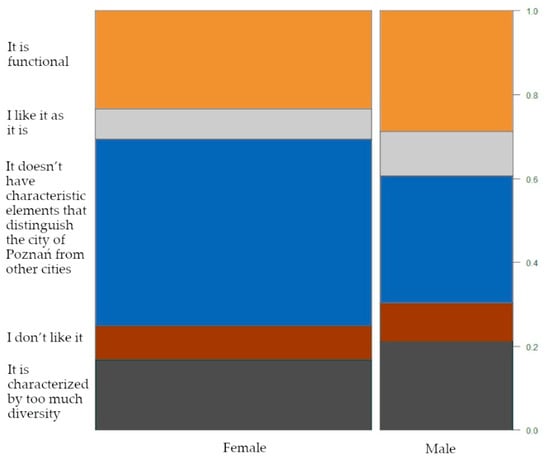
Figure 9.
Results of responses to the question, “What is your opinion of existing urban furniture?” (Own source).
Based on the statistical analysis, a significant relationship was found between gender and the perception of the issue of the popularity of urban furniture in public space (question 7). According to both men and women, the most important aspect determining the popularity of furniture is its appropriate placement in urban space (41% and 38% of responses). A total of 36% of women felt that the popularity of furniture is determined by its fit to the needs of users, and only 15% by its aesthetics. According to 32% of men, it is the aesthetics of urban furniture that is the decisive criterion, while the issue of their adaptation to the needs of users was highlighted by 27% of male respondents. Thus, the trend is reversed, which can be explained by the fact that the young men surveyed “sharpened” their sense of aesthetics during their education in faculties profiled in this direction. For both groups, the least important aspect was the number of pieces of furniture (7% women and 3% men).
Urban furniture also has a significant impact on the aesthetics of the city. Nearly 95% of respondents said that properly arranging public spaces with urban furniture can improve the aesthetics of the street and the quality of life of residents. At the same time, only a few respondents declared that they like the urban furniture in Poznań as it is (Figure 9).
As the features most relevant to the evaluation of urban furniture, the most frequently indicated responses were technical condition, material, composing with the surroundings, and shape (Figure 10). The numerous responses about the importance of composing urban elements with the environment confirm the great role of this aspect in design. Unquestionably, it is its importance that is raised by the direction of the respondents’ education. Among others, respondents mentioned such qualities as cleanliness, comfort of use, and the aforementioned ergonomics.
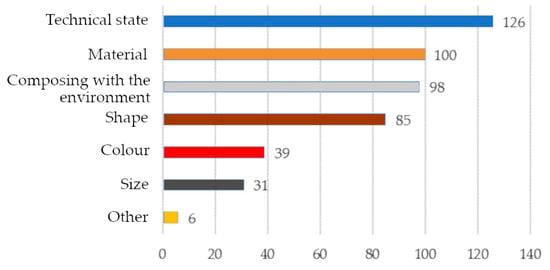
Figure 10.
Results of responses to the question “What features do you pay attention to when evaluating urban furniture?” (Own source).
Participants in the survey say that urban furniture is most exposed to the weather. As many as 127 people gave such answers, accounting for 62.6%. In addition, according to 35.5% of respondents, urban furniture is exposed to vandalism. By the way, following Pizatto and de Macedo [43], products with emotional appeal to users tend to be less vandalised. These results are a very important guideline at the stage of designing urban furniture. They show what should be paid special attention to, and emphasise the importance of the right choice of material, both for the comfort of use and the negative impact of atmospheric factors, which also affect the later technical condition of the elements. However, taking into account the conclusions of Pizatto and de Macedo [43], it is not only a matter of the materials used to produce urban furniture, but also the emotional attributes of it.
When asked about the forms of spending time, respondents could choose up to three out of six proposed answers (Figure 11). The results show that users most often spend time in public spaces for socialising and relaxing. Such answers were given by, respectively: 140 and 128 people. More than half as many responses were given to reading, eating, and physical activity. The least popular form of spending time is playing games, which should be seen as a positive sign, indicating the competitiveness of other activities.
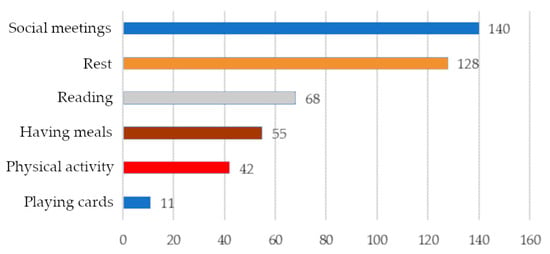
Figure 11.
Results of responses to the question “What forms of spending time do you prefer in public spaces?” (Own source).
Survey participants were also asked about their seating preferences. More than half of the respondents answered that they preferred seats designed in a partial circle style. Slightly fewer chose the line style. The results are shown in Figure 12.
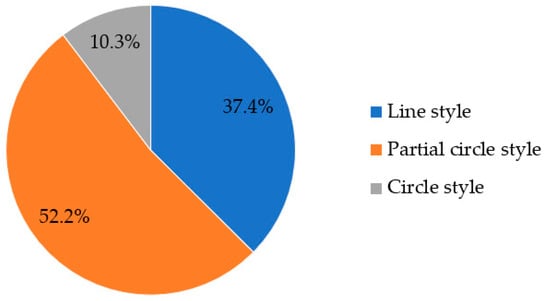
Figure 12.
Results of responses to the question, “What seating arrangement in public spaces do you prefer?” (Own source).
Seating style preferences are related to the type of public spaces. Indeed, more than 55% of respondents answered that they prefer semi-open spaces, which encourage both interaction and solitude. The partial circle style undoubtedly facilitates the creation of such a space, as the positioning of benches in a semi-circle encourages conversation, but also provides opportunities for isolation. Nearly a third of the students surveyed indicated open spaces that encourage conversation and contact with others, while only 28 prefer silence and solitude. Statistically significant differences were found between the male and female groups regarding the type of space preferred (Table 1, Figure 13). The vast majority of female respondents prefer semi-open spaces, conducive to both interaction and solitude (62%), while only 23% choose open spaces. Among men, open spaces are most often approved (47%), and semi-open spaces less often (41%), which is somewhat consistent with the answer to the question about the frequency of use of open spaces in the city. Both men and women, however, are least likely to choose isolated spaces (15% and 12% of respondents, respectively).
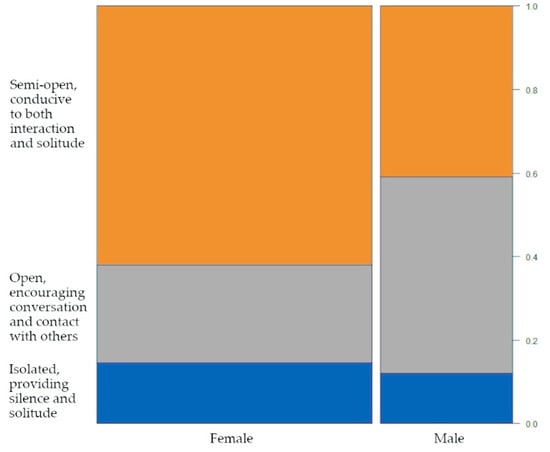
Figure 13.
Results of responses to the question, “What kind of space do you prefer?” (Own source).
The second part of the survey referred to parklets. The first question concerned familiarity with the concept itself. The results show that only less than 30% of respondents have encountered the concept of parklets. This confirms the newness of the idea in Poland and the still insufficient knowledge among the public about it. Faced with a choice between parking spaces and parklets, more than 60% of respondents opted to reduce parking areas in favour of new dedicated public spaces (Figure 14). This demonstrates the need to plan new places in the urban space where residents could spend their time and the partial need to relieve the urban space from motorisation. Figure 15 shows the structure of the missing urban furniture responses in the groups preferring different types of spaces.
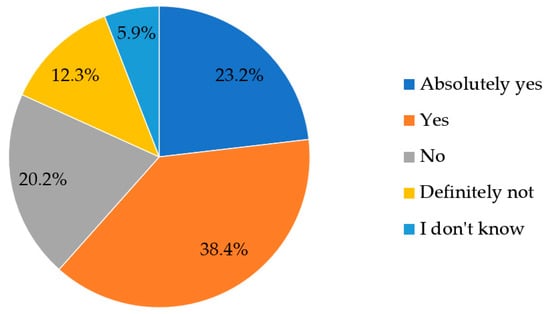
Figure 14.
Results of responses to the question, “Are you in favour of reducing the number of traditional parking spaces to parklets?” (Own source).
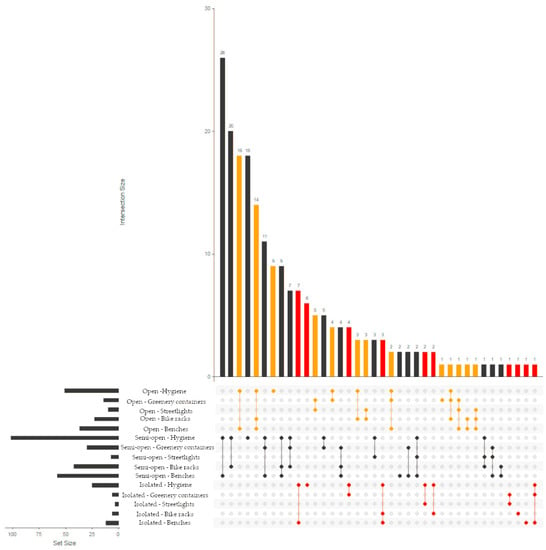
Figure 15.
Structure of respondents’ answers regarding missing urban furniture by space preference (open, semi-open, isolated).
The students were also asked about the urban furniture they thought the parklet should be equipped with (Figure 16). For this question, too, they were given the opportunity to select up to three answers. The most frequently chosen urban furniture was a bench, followed closely by a waste bin. These two items, according to respondents, appeared to be necessary on the parklet platform, indicating the need for even a short stop on the parklet, but in comfort. A similar number of responses were given to the other proposed urban furniture, i.e., the greenery container, the bike rack, and the lantern. Tables and deck chairs were identified by respondents as others.
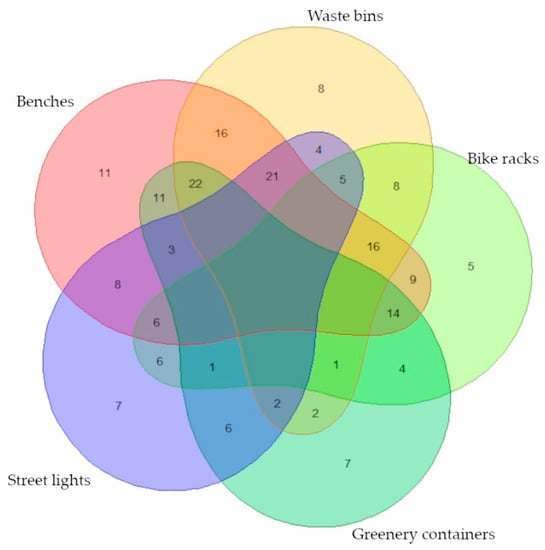
Figure 16.
Structure of respondents’ answers regarding missing urban furniture by space preference (open, semi-open, isolated).
Survey participants believe that the parklet concept has a chance to develop in Poland. A total of 74% of respondents answered “yes” and “definitely yes,” both among women and men. This result signals positive reception, for the majority, of the new concept and gives an optimistic picture for the development of the idea in the future.
5. Conclusions
The answers given by the students from Poznań, Poland and their analysis indicated the issues worthy of being paid attention to during design, so that planned public spaces are fully used in a rational and modern way, and urban furniture is created in accordance with the preferences of residents.
In the opinion of the authors of this work, conducting surveys among young people studying majors related to the subject of the article was particularly justified, because it allowed us to know not only their preferences, but also to find out about their awareness of the rational and modern management of urban space with respect for the environment. However, because the target group was not a homogenous representation of the end users, further studies are recommended to address the issue from the perspective of other groups.
A review of bibliographic sources, taking into account the history of urban furniture and contemporary development trends, indicates that despite the existence of these elements for a very long time, the conscious management of public space and the arrangement of urban furniture in it is a new issue generally but in Poland particularly.
A new and hopeful form is parklets, creating a new public space developed with urban furniture. The authors of this paper believe that this is an opportunity for compact cities that lack public spaces. It provides an opportunity for both short leisure and longer time and makes urban space more attractive.
A new perception of urban furniture at both the design of it and its use has appeared in the context of the COVID-19 pandemic.
Author Contributions
Conceptualisation, A.M.G., A.Ł. and W.W.; methodology, A.Ł. and W.W.; software, A.Ł.; validation, A.M.G. and A.Ł; formal analysis, A.M.G. and A.Ł.; investigation, A.M.G. and W.W.; resources, A.M.G. and W.W.; data curation, A.M.G.; writing—original draft preparation, A.M.G. and A.Ł.; writing—review and editing, A.M.G.; supervision, A.M.G. All authors have read and agreed to the published version of the manuscript.
Funding
Co-financed within the framework of the Polish Ministry of Science and Higher Education’s program: “Regional Initiative Excellence” in the years 2019–2023 (No. 005/RID/2018/19), financing amount 12,000,000 PLN.
Institutional Review Board Statement
Not applicable.
Informed Consent Statement
Not applicable.
Data Availability Statement
Not applicable.
Conflicts of Interest
The authors declare no conflict of interest.
Appendix A
- Do you think that the number of dedicated public spaces in the city of Poznań is sufficient?
- Absolutely yes
- Yes
- No
- Definitely not
- I don’t know
- How often do you use city furniture?
- Every day
- Once a week
- Once a month
- Once a year
- Never
- Do you think that the number of urban furniture in the city of Poznan is sufficient?
- Absolutely yes
- Yes
- No
- Definitely not
- I don’t know
- What urban furniture do you think is missing in the public space of the city of Poznań? (please mark up to 3 answers)
- Benches
- Waste bins
- Streetlights
- Bike racks
- Greenery containers
- Public toilets
- Containers for dog excrement
- Other: …………………………………………………………………………………
- Where do you think there is a need for more urban furniture?
- In the city centre
- On the outskirts of the city
- In parks and landscaped urban green areas
- In the areas of shopping centres and large stores
- Other: …………………………………………………………………………………
- What is your opinion of existing urban furniture?
- I like it as it is
- It is functional
- It is characterized by too much diversity
- I don’t like it
- It doesn’t have characteristic elements that distinguish the city of Poznan from other cities
- Other: …………………………………………………………………………………
- What do you think determines the popularity of urban public space furniture?
- Appropriate arrangement of urban furniture
- Number of urban furniture
- Tailoring urban furniture to users’ needs
- Aesthetics of urban furniture
- Other: …………………………………………………………………………………
- Do you think that proper arrangement of public space with urban furniture can improve the aesthetics of the street and the quality of life of residents?
- Absolutely yes
- Yes
- No
- Definitely not
- I don’t know
- What features do you pay attention to when evaluating urban furniture? (please mark up to 3 answers)
- Colour
- Shape
- Material
- Composing with the environment
- Technical state
- Size
- Other: …………………………………………………………………………………
- What do you think urban furniture in public spaces is most vulnerable to?
- Weather conditions
- Vandalism
- Other: …………………………………………………………………………………
- What forms of spending time do you prefer in public spaces?
- Reading
- Physical activity
- Having meals
- Rest
- Playing cards
- Social meetings
- Other: …………………………………………………………………………………
- What seating arrangement in the public space do you prefer?

- What kind of space do you prefer?
- Open, encouraging conversation and contact with others
- Isolated, providing silence and solitude
- Semi-open, conducive to both interaction and solitude
- Have you encountered the concept of parklets?
- Yes
- No
- Are you in favour of reducing number of traditional parking spaces for parklets?
- Absolutely yes
- Yes
- No
- Definitely not
- I don’t know
- Which of the listed city furniture do you think the parklet should be equipped with?
- Benches
- Waste bins
- Bike racks
- Street lights
- Greenery containers
- Other: …………………………………………………………………………………
- Do you think the parklet concept has a chance to develop in Poland?
- Absolutely yes
- Yes
- No
- Definitely not
- I don’t know
- Which university in Poznań are you a student of?
- …………………………………………………………………………………………
- Sex
- Female
- Male
References
- Carmona, M. Principles for Public Space Design, Planning to Do Better. Urban Des. Int. 2019, 24, 47–59. [Google Scholar] [CrossRef]
- Yang, Z. Street Furniture and Urban Aesthetics (Chinese Ed.); Tianjin University Press: Tianjin, China, 2005. [Google Scholar]
- Lynch, K. The Image of the City; MIT Press: Cmbridge, MA, USA, 1964; ISBN 0-262-62001-4. [Google Scholar]
- Bao, S.D.; Wang, H.L.; Sun, M.H.; Huang, G.; Yu, Y.; Ge, R.; Wang, P. Urban Furniture System Design. Chinese Ed.; China Architecture and Building Press: Beijing, China, 2006. [Google Scholar]
- Wan, P.H. Street Furniture Design Principles and Implementations: Case Studies of Street Furniture Design in Densely Populated Old Urban Areas. Master’s Thesis, School of Design, The Hong Kong Polytechnic University, Hong Kong, China, 2008. [Google Scholar]
- Cymer, A. Z Meblem Miejskim Przez Wieki. In Biblioteka Wizerunku Miasta, cz. 3; Goślińska, K., Ed.; AMS SA: Warszawa, Poland, 2007; Volume 3, pp. 9–13. [Google Scholar]
- Kaya, H.S.; Kaya, M.E.; Yakut, E.S.; Çiçek, M.; Tozluoğlu, G. An Interdisciplinary Urban Furniture Design Model. A|Z Itu J. Fac. Archit. 2022, 19, 721–740. [Google Scholar] [CrossRef]
- Whyte, W.H. The Social Life of Small Urban Spaces; Conservation Foundation: Washington, DC, USA, 1980; ISBN 978-0-89164-057-8. [Google Scholar]
- Gehl, J. Life between Buildings: Using Public Space; Island Press: Washington, DC, USA, 2012; ISBN 978-1-61091-023-1. [Google Scholar]
- Main, B.; Hannah, G.G. Site Furnishings: A Complete Guide to the Planning, Selection and Use of Landscape Furniture and Amenities; John Wiley & Sons: Hoboken, NJ, USA, 2010; ISBN 978-0-470-63939-9. [Google Scholar]
- Wan, P.H.; Siu, K.W.M. Quality in Design: Creating Identity in Street Furniture Design. In Proceedings of the 13th ISSAT International Conference on Reliability and Quality in Design, Seattle, WA, USA, 2–4 August 2007; pp. 78–83. [Google Scholar]
- Telford, T.; Quay, H. Manual for Streets; Thomas Telford Publishing: London, UK, 2007; ISBN 978-0-7277-3501-0. [Google Scholar]
- Bulduk, B. An Analysis of the Use of Urban Furniture in City Advertising in Terms of Aesthetic/Visual Appreciation Training: City Design. Procedia—Soc. Behav. Sci. 2012, 46, 3279–3283. [Google Scholar] [CrossRef][Green Version]
- Gupta, N.; Bhatti, V. Importance of Street Furniture in Urban Landscape. Int. J. Latest Trends Eng. Technol. (IJLTET) 2015, 5, 174–179. [Google Scholar]
- Lee, Y.B.; Chan, L.D.; Tang, M.X. Park Seating Furniture Design in Hong Kong: A Case Study of Inclusive Design and Its Relation to User Interaction. In Proceedings of the Include Asia 2013, Hong Kong, China, 2–3 July 2013. [Google Scholar]
- Luximon, Y.; Kwong, H.Y.; Tai, Y.Y. User Preferences of Urban Park Seating Pattern in Hong Kong. Procedia Manuf. 2015, 3, 4273–4278. [Google Scholar] [CrossRef]
- Sanches, M.G.; Frankel, L. Co-Design in Public Spaces: An Interdisciplinary Approach to Street Furniture Development. In Proceedings of the Design and Complexity—DRS International Conference 2010, Montreal, QC, Canada, 7–9 July 2010. [Google Scholar]
- Susanto, D.; Ilmiani, A.N. Flexible Furniture: A Design Strategy for Multiuse yet Limited Space in the Urban Kampung; IEEE: Kuala Lumpur, Malaysia, 2018; pp. 26–31. [Google Scholar]
- Bentley, I.; Alcock, A.; Murrain, P.; McGlynn, S.; Smith, G. Responsive Environments: A Manual for Designers; Routledge: London, UK, 1985; ISBN 978-0-7506-0566-3. [Google Scholar]
- Soffritti, C.; Calzolari, L.; Chicca, M.; Neri, R.B.; Neri, A.; Bazzocchi, L.; Garagnani, G.L. Cast Iron Street Furniture: A Historical Review. Endeavour 2020, 44, 100721. [Google Scholar] [CrossRef]
- Kimic, K. Meble Miejskie i Ich Rola w Kszta\ltowaniu Przestrzeni (Street Furniture and Its Role in Shaping the Space–in Polish). Zieleń Miejska Plus 2015, 1, 4–6. [Google Scholar]
- Yücel, G.F. Street Furniture and Amenities: Designing the User-Oriented Urban Landscape. In Advances in Landscape Architecture; IntechOpen: London, UK, 2013; ISBN 978-953-51-1167-2. [Google Scholar]
- Barcic, A.P.; Oblak, L.; Motik, D.; Govedic, T.B.; Kopljar, A.; Vukovic, A. Street Furniture in Croatia and Slovenia-Park Users Requirements for (WOOD) Urban Equipment. In Increasing the Use of Wood in the Global Bio-Economy-Proceedings of Scientific Papers; University of Belgrade, Faculty of forestry: Belgrade, Serbia, 2018; pp. 46–55. [Google Scholar]
- Alves, M.; Lopes, L.; Alves, J.L.; de Carvalho, F.X. Urbcork–Urban Furniture with Application of High Density Cork. Ciência Tecnol. Dos Mater. 2017, 29, e270–e274. [Google Scholar] [CrossRef]
- Sanchez-Roldan, Z.; Martin-Morales, M.; Valverde-Espinosa, I.; Zamorano, M. Technical Feasibility of Using Recycled Aggregates to Produce Eco-Friendly Urban Furniture. Constr. Build. Mater. 2020, 250, 118890. [Google Scholar] [CrossRef]
- Bedoya, M.; Rivera, F.; Rico, M.; Vélez, D.; Urrego, A.; Hernandez, S. Sustainable Concrete Application in the Manufacture of University Urban Furniture. EDP Sci. MATEC Web Conf. 2019, 303, 05001. [Google Scholar] [CrossRef]
- Thamrin, D.; Mulyono, G. Usability Evaluation of Adaptable Urban Park Furniture Product with Cellular Light-Weight Concrete as Material. IOP Conf. Ser. Mater. Sci. Eng. 2018, 408, 012033. [Google Scholar] [CrossRef]
- Avila, M.; Toledo, J.; Córdova, F.; Icaza, D.; de los Angeles Tello, M. Intelligent Multifunctional Solar Urban Furniture: A Multidisciplinary Methodological Vision of Technology. In Proceedings of the 2018 International Conference on Smart Grid (icSmartGrid), Nagasaki, Japan, 4–6 December 2018; IEEE: Nagasaki, Japan, 2018; pp. 184–194. [Google Scholar]
- Premier, A.; GhaffarianHoseini, A.; GhaffarianHoseini, A. Solar-Powered Smart Urban Furniture: Preliminary Investigation on Limits and Potentials of Current Designs. Smart Sustain. Built Environ. 2022, 11, 334–345. [Google Scholar] [CrossRef]
- Dahy, H. Natural Fibre-Reinforced Polymer Composites (NFRP) Fabricated from Lignocellulosic Fibres for Future Sustainable Architectural Applications, Case Studies: Segmented-Shell Construction, Acoustic Panels, and Furniture. Sensors 2019, 19, 738. [Google Scholar] [CrossRef] [PubMed]
- Chandekar, H.; Chaudhari, V.; Waigaonkar, S. A Review of Jute Fiber Reinforced Polymer Composites. Mater. Today Proc. 2020, 26, 2079–2082. [Google Scholar] [CrossRef]
- Cetin, M.S.; Ipek, M.; Fidan, G.; Toprakci, O.; Karahan Toprakci, H.A. Bio-Based Sustainable Composites from Hazelnut Shell and PP/SEBS Blends. J. Thermoplast. Compos. Mater. 2022, 08927057221115344. [Google Scholar] [CrossRef]
- Nguyen, M.T.; Solueva, D.; Spyridonos, E.; Dahy, H. Mycomerge: Fabrication of Mycelium-Based Natural Fiber Reinforced Composites on a Rattan Framework. Biomimetics 2022, 7, 42. [Google Scholar] [CrossRef]
- Ye, H.; Wang, Y.; Yu, Q.; Ge, S.; Fan, W.; Zhang, M.; Huang, Z.; Manzo, M.; Cai, L.; Wang, L. Bio-Based Composites Fabricated from Wood Fibers through Self-Bonding Technology. Chemosphere 2022, 287, 132436. [Google Scholar] [CrossRef] [PubMed]
- Nowghabi, A.S.; Talebzadeh, A. Psychological Influence of Advertising Billboards on City Sight. Civ. Eng. J. 2019, 5, 390–397. [Google Scholar] [CrossRef]
- Thorpert, P.; Englund, J.-E. Colour Perception and Visitor Experiences of Urban Parks as Influenced by an Intense Colourful Urban Artefact: An In-Situ Quasi-Experiment. ICONARP Int. J. Archit. Plan. 2021, 9, 2. [Google Scholar] [CrossRef]
- Gedliczka, A. Atlas Miar Człowieka: Dane Do Projektowania i Oceny Ergonomicznej; CIOP: Warszawa, Poland, 2001; ISBN 83-88703-38-2. [Google Scholar]
- Gould, S. Parklets: Tiny Parks with Big Impacts for City Streets; SvR Design: Seattle, WA, USA, 2012. [Google Scholar]
- Ardura, A.; Dopico, E.; Fernandez, S.; Garcia-Vazquez, E. Citizen Volunteers Detect SARS-CoV-2 RNA from Outdoor Urban Fomites. Sci. Total Environ. 2021, 787, 147719. [Google Scholar] [CrossRef]
- Askarizad, R.; He, J. Post-Pandemic Urban Design: The Equilibrium between Social Distancing and Social Interactions within the Built Environment. Cities 2022, 124, 103618. [Google Scholar] [CrossRef] [PubMed]
- Mansuroğlu, S.; Dağ, V.; Önaç, A.K.; Söğüt, Z.; Birişçi, T. Approaches of Landscape Architects to Applications for the Use of Open and Green Spaces in Conditions of Covid-19 Pandemic. Megaron 2021, 16, 559–573. [Google Scholar] [CrossRef]
- Hope, A.C. A Simplified Monte Carlo Significance Test Procedure. J. R. Stat. Soc. Ser. B (Methodol.) 1968, 30, 582–598. [Google Scholar] [CrossRef]
- Pizzato, G.Z.; Macedo Guimarães, L.B. de Emotional Attributes of Urban Furniture. In Proceedings of the Congress of the International Ergonomics Association, Florence, Italy, 26 August 2018; Springer: Florence, Italy, 2018; pp. 2087–2097. [Google Scholar]
Publisher’s Note: MDPI stays neutral with regard to jurisdictional claims in published maps and institutional affiliations. |
© 2022 by the authors. Licensee MDPI, Basel, Switzerland. This article is an open access article distributed under the terms and conditions of the Creative Commons Attribution (CC BY) license (https://creativecommons.org/licenses/by/4.0/).